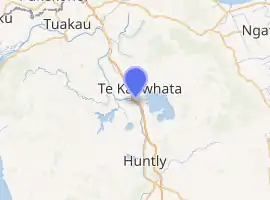Rangiriri
Rangiriri is a rural community in the Waikato District and Waikato region of New Zealand's North Island. It is located on the Waikato River near Lake Waikare in the Waikato District. State Highway 1 now bypasses Rangiriri.
Rangiriri | |
|---|---|
.jpg.webp) Rangiriri Pub | |

| |
| Country | New Zealand |
| Region | Waikato |
| District | Waikato |
| Population (2018) | |
| • Total | 1,833 |
Rangiriri was the site of a major Māori defence structure during the time of the Invasion of the Waikato, the major campaign of the New Zealand Wars. The Battle of Rangiriri, which took place on 20–21 November 1863, cost both sides more than any other engagement of the land wars and also resulted in the capture of 183 Māori prisoners, which impacted on their subsequent ability to oppose the far bigger British force.[1]

As part of work on the Waikato Expressway, the NZ Transport Agency has restored a pā site that straddled State Highway 1; the work was completed for the 150th anniversary of the battle.[2]
Rangiriri has two marae belonging to the Waikato Tainui hapū of Ngāti Hine, Ngāti Naho, Ngāti Pou and Ngāti Taratikitiki:[3] Horahora Marae and Te Whare i Whakaarohia meeting house, and Maurea Marae and Ngā Tumutumu o Rauwhitu meeting house.[4] Both are located on the western side of the Waikato River.[4]
Demographics
| Year | Pop. | ±% p.a. |
|---|---|---|
| 2006 | 1,029 | — |
| 2013 | 1,836 | +8.62% |
| 2018 | 1,833 | −0.03% |
| Source: [5] | ||
The statistical area of Rangiriri, which at 137 square kilometres is much larger than the locality, surrounds but does not include Te Kauwhata. It had a population of 1,833 at the 2018 New Zealand census, a decrease of 3 people (-0.2%) since the 2013 census, and an increase of 804 people (78.1%) since the 2006 census. There were 477 households. There were 1,164 males and 669 females, giving a sex ratio of 1.74 males per female. The median age was 38.8 years, with 291 people (15.9%) aged under 15 years, 372 (20.3%) aged 15 to 29, 942 (51.4%) aged 30 to 64, and 225 (12.3%) aged 65 or older.
Ethnicities were 73.5% European/Pākehā, 26.0% Māori, 7.0% Pacific peoples, 4.6% Asian, and 1.8% other ethnicities (totals add to more than 100% since people could identify with multiple ethnicities).
The proportion of people born overseas was 14.9%, compared with 27.1% nationally.
Although some people objected to giving their religion, 53.2% had no religion, 33.6% were Christian, 0.5% were Hindu, 1.0% were Muslim, 0.3% were Buddhist and 4.3% had other religions.
Of those at least 15 years old, 159 (10.3%) people had a bachelor or higher degree, and 327 (21.2%) people had no formal qualifications. The median income was $22,500. The employment status of those at least 15 was that 690 (44.7%) people were employed full-time, 195 (12.6%) were part-time, and 114 (7.4%) were unemployed.[5]
Bridge
To replace a punt, which had been operating since at least 1900,[6] a timber truss bridge,[7] with ferro-concrete piles, was started in 1915[8] and probably opened in 1917.[9] It partly collapsed, but was strengthened to allow light traffic. Demolition of the old bridge cost $30,000.[10]

About 1969 a single-lane replacement, designed by Murray-North Partners, was built downstream for £204,800 (National Roads Board £182,300, Raglan County Council £15,525, Waikato County Council £6975).[10] It is 900 ft (270 m) long, with 8 spans, 6 of 120 ft (37 m). The 2-cell H-section box girder is formed of 3 prestressed, post-tensioned segmented concrete flanged beams. The design was the first in this country to combine precast units into a continuous box girder.[7]
In 2019 it carried about 1,640 vehicles a day on Glen Murray Rd.[11]
Education
Te Kura o Rangiriri is a co-educational state primary school for Year 1 to 8 students,[12] with a roll of 28 as of March 2020.[13][14]
References
- "Rangiriri". Ministry for Culture and Heritage. 24 June 2014. Retrieved 24 May 2015.
- "Rangiriri Bypass" (PDF). NZ Transport Agency. Retrieved 24 May 2015.
- "Te Kāhui Māngai directory". tkm.govt.nz. Te Puni Kōkiri.
- "Māori Maps". maorimaps.com. Te Potiki National Trust.
- "Statistical area 1 dataset for 2018 Census". Statistics New Zealand. March 2020. Rangiriri (170800). 2018 Census place summary: Rangiriri
- "NEWS FROM COUNTRY DISTRICTS. (New Zealand Herald, 1900-01-04)". paperspast.natlib.govt.nz National Library of New Zealand. Retrieved 15 June 2017.
- "Innovate NZTM Awards of Excellence, 1965 – 2015: 1973 – Rangiriri Bridge, Rangiriri by Murray-North Partners (J. C. North and R. F. Swarbrick)" (PDF). Association of Consulting and Engineering Professionals in New Zealand (ACENZ). 2015.
- "RANGIRIRI. (Pukekohe & Waiuku Times, 1917-05-18)". paperspast.natlib.govt.nz National Library of New Zealand. Retrieved 14 June 2017.
- "RANGIRIRI (Pukekohe & Waiuku Times, 1918-03-01)". paperspast.natlib.govt.nz National Library of New Zealand. Retrieved 14 June 2017.
- CW Vennell & Susan Williams (1976). Raglan County Hills and Sea 1876–1976. Wilson & Horton for Raglan County Council. p. 292. ISBN 0868640026.
- "Traffic and Loading -" (PDF). Waikato District Council. 5 June 2019.
- "Ministry of Education School Profile". educationcounts.govt.nz. Ministry of Education.
- "New Zealand Schools Directory". New Zealand Ministry of Education. Retrieved 26 April 2020.
- "Education Review Office Report". ero.govt.nz. Education Review Office.
